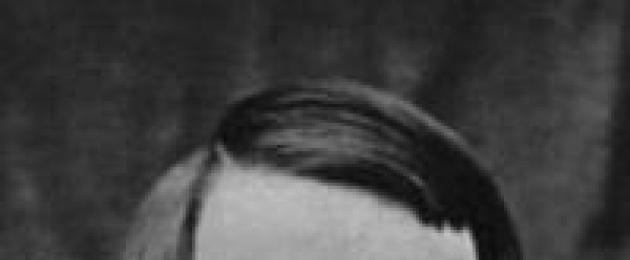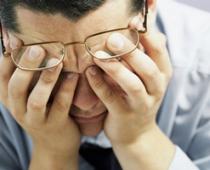Hermann Ludwig Ferdinand von Helmholtz (Hermann von Helmholtz) is considered a national treasure in Germany. He managed to become the first doctor among scientists and the first scientist among doctors.
With the name of a doctor, mathematician, psychologist, professor of physiology and physics Helmholtz - inventor of the eye mirror, in the 19th century, the fundamental reconstruction of physiological concepts was inextricably linked. A brilliant expert in higher mathematics and theoretical physics, he put these sciences at the service of physiology and achieved outstanding results.
Müller used momentum as an example of a vital function that would never have been presented to experimental measurements. Helmholtz discovered that this pulse was completely measurable and had a surprisingly slow speed of about 90 feet per second. The slowness of the nerve impulse further supported those who insisted that it should include a rearrangement of weighty molecules, and not the mysterious passage of vital force.
Among the most valuable inventions of Helmholtz were the ophthalmometer, made while working on it, and, by the way, showing that it was a rather imperfect piece of skill, not at all consonant with the vitalistic idea of the divine mind at work, Helmholtz discovered that he could focus reflected from it to create a sharp fabric image. The ophthalmoscope remains one of the most important tools of a physician, who can use it to study retinal blood vessels, from which signs and arterial disease can be observed.
Studying his biography, you do not cease to be surprised and admire: he had a bad memory, he studied very mediocre and graduated from the gymnasium with a sin in half. During his studies at the gymnasium, no one could even think that he would do so much useful things in science! However, Hermann became an outstanding physiologist.
Hermann's father Augustus-Ferdinand-Julius Helmholtz (1792-1859) received a higher education at the University of Berlin, where he first studied at the theological faculty and studied philosophy. In 1820, he passed a special exam and received a place as a senior teacher in the Potsdam gymnasium.
An ophthalmometer can measure eye placement in changing optical conditions, allowing, among other things, the proper assignment of glasses. Helmholtz’s research on the eye was included in his “Handbook of physiological optics”, the first volume of which appeared in the second volume, Helmholtz further investigated optical phenomena and, more importantly, faced a philosophical problem that should have taken him for some years - Kant’s perseverance that such basic concepts as time and space were not studied by experience, but were provided by the mind in order to understand what the mind perceived.
In the first year of his teaching, he married Caroline Penn. In the gymnasium August Ferdinand taught German, philosophy, interpreted Plato, read Homer, Virgil, Ovid, and even at one time taught mathematics and physics. A favorite subject, however, was Greek literature and culture. As an outstanding teacher in 1827, he was appointed as a sub-director, and a year later he was promoted to professor.
The problem was significantly complicated by Muller’s statement of what he called the law of specific nerve energies. Muller found that sensory organs always “communicate” their own meaning, no matter how stimulated they are. For example, a blow to the eye, which has nothing to do with optical phenomena, causes the recipient to "see the stars." Obviously, the eye does not accurately report the outside world, since reality is a blow, not a star. How, then, can one be sure that feelings communicate about the outside world?
Helmholtz examined this issue in detail both in his work on optics and in his workshop. What he was trying to do, without complete success, was to trace the sensations through the sensory nerves and anatomical structures in the brain in the hope of exposing the full mechanism of sensation. This task, it can be noted, was not completed, and physiologists are still involved in solving the mystery of how the mind knows something about the outside world.
When in the same gymnasium his son Herman began to study, languages were given him more difficult than others, he barely mastered history, he was tormented to learn by heart passages in prose. When Cicero or Virgil was read in class, he calculated the course of rays in telescopes under the table and already found some optical theorems about which nothing was said in textbooks.
A detailed study of the vision of Helmholtz allowed him to refute the theory of Kant's space, accurately demonstrating how the feeling of vision arose. Space, according to Helmholtz, was understandable, not conceptual. Moreover, Helmholtz also attacked Kant's insistence that space was necessarily three-dimensional, because that was how the mind should have conceived it. Using his considerable mathematical talents, he explored the properties of non-Euclidean space and showed that they could be conceived and worked out as easily as the three dimensions.
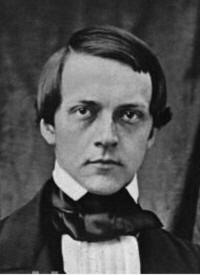 In 1838, Herman graduated from high school, and the question arose about choosing a career. Of all the sciences, he was most attracted to natural science. However, the lack of the necessary funds made Herman's father advise his son not to go to the Faculty of Natural Sciences, and Herman decided to study medicine, which could help him in the future to work in such a way as not to interrupt his studies in physics and mathematics.
In 1838, Herman graduated from high school, and the question arose about choosing a career. Of all the sciences, he was most attracted to natural science. However, the lack of the necessary funds made Herman's father advise his son not to go to the Faculty of Natural Sciences, and Herman decided to study medicine, which could help him in the future to work in such a way as not to interrupt his studies in physics and mathematics.
Helmholtz’s mathematical talents were not limited to theoretical planes such as. He attacked and solved equations that upset physicists and mathematicians long ago. One consequence of Helmholtz’s mathematical analysis was that the eddies of them were surprisingly stable; they may collide elastically with each other, intertwine, forming complex, nodal-like structures and experience stress and contraction without losing their identity. It seemed that Faraday struck the base of Newtonian physics with his unorthodox refusal to act at a distance, i.e. action between two bodies in space without changing the environment between them.
The only relative involved in science in the Helmholtz family was Murenin, who held a prominent position. He undertook to patrol Hermann into the public account of the Friedrich-Wilhelm Military Medical-Surgical Institute in Berlin, which trained military doctors.
A seventeen-year-old student in the first semester studied physics, chemistry and anatomy and for the first year he listened to logic, history, Latin and French. Herman was lucky not only with fellow students (a whole galaxy of future physiotherapists learned the colors of German science: Karl Ludwig, Dubois-Reymond, Brücke, Virchow, Schwann), but also with physiology teacher Johannes Muller, the luminary of German physiological science.
However, Maxwell, interpreting the mathematics of the Faraday laws, showed that there was no contradiction between Newtonian physics and classical mechanics. Helmholtz developed the mathematics of electrodynamics. In recent years, he unsuccessfully tried to reduce all electrodynamics to a minimal set of mathematical principles, an attempt in which he had to rely more and more on the mechanical properties of thought in order to permeate all space.
Helmholtz did not fully agree with Maxwell regarding the nature of electricity. Unlike Maxwell, Helmholtz was interested in and studied electrochemistry, in particular the nature of electroplating and, ironically, the physics of its existence helped falsify the Helmholtz theory of electrodynamics.
The students of Muller were united by the same desire to connect physics with physiology and find a more solid foundation for their substantiation. Herman was significantly superior to his friends in the knowledge of mathematics, which gave him the opportunity to accurately "formulate problems and give the right direction by solving them."
The work of Hermann Helmholtz in Muller’s laboratory, which began brilliantly during his student years and captured him, was interrupted in the fall of 1842 with practical work as a surgeon at the Charite Military Hospital in Berlin, which lasted a whole year and took away his daily time from 7 am to 8 pm. Nevertheless, on November 2, 1842, Hermann defended his doctoral thesis in Latin "On the structure of the invertebrate nervous system." The topic was offered to him by Muller himself. In this dissertation, a young scientist for the first time proved that the well-known elements of the nervous tissue - the nerve cells and fibers are connected to each other and form parts of an inseparable whole, later called neuron.
Although he was not successful in formulating electrodynamics, Helmholtz was almost able to deduce all the electromagnetic effects from the alleged properties of ether. Special and general theories of relativity proposed, destroyed the theory of Helmholtz, eliminating the ether.
Helmholtz's early work on sound and music led him to study. His energy conservation work introduced him to the problems of energy transfer. These two areas came together in his last years in his research on meteorology, but the phenomena were so complex that he could do a little more than point the way to future areas of research.
After graduation, Helmholtz is sent to the famous Berlin Charité Hospital as an ordinator, and Virchow worked there. At the same time, he works in the home laboratory of Gustav Magnus, the author of publications on mechanics, hydrodynamics, heat, etc. Helmholtz was facing a seven-year working out of the scholarship as a military doctor. He managed to get a job in Potsdam, not far from Berlin: in October 1843 he served as a squadron surgeon of the Royal Life Guards Hussars. Helmholtz lived in the barracks, got up like everyone else at five o'clock in the morning on a signal from the cavalry pipe. Despite all the inconveniences of barracks life, he managed to arrange a small physical and physiological laboratory and in 1845 made his experiments on the consumption of substances during muscular work, for which Dubois-Raymond handed him portable scales.
On the recommendation of Johannes Muller, Helmholtz was invited in 1849 as a professor of physiology to the University of Königsberg. In Konigsberg, he designed a number of original measuring instruments. The most famous device designed by him is an eye mirror (ophthalmoscope)which made it possible to observe the fundus of the eye, and so on. Helmholtz pendulum, which allows to expose the fabric quickly following successive irritations with an accurate dosage of time. And nowadays, the ophthalmoscope plays a huge role in the diagnosis of not only eye diseases, but also nervous diseases, such as tumors of the brain, spinois of the spinal cord, etc.
At the ophthalmological congress in Paris, where in 1867 he read a report on relief, they said at a ceremonial dinner: “Ophthalmology was in the darkness; “God said Helmholtz was born, and the light shone”.
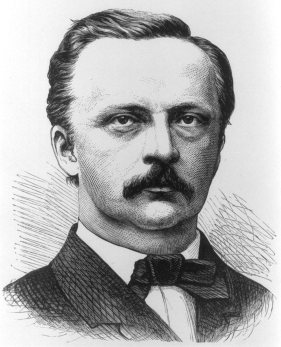 The Koenigsberg period of scientific activity of Helmholtz was the most productive. There he also developed a physiological theory of hearing, according to which the resonance phenomenon is based on the ability to distinguish between sound tones.
The Koenigsberg period of scientific activity of Helmholtz was the most productive. There he also developed a physiological theory of hearing, according to which the resonance phenomenon is based on the ability to distinguish between sound tones.
The works of Helmholtz in the field of physiology are devoted to the study of the nervous and muscular systems. He discovered and measured the heat generation in the muscle by the thermoelectric method (1845-1847) and, using the graphical method developed by him, studied in detail the process of muscle contraction in experiments on a frog.
Large-scale works, which brought world renown to Helmholtz and attracted the attention of the Paris Academy of Sciences, prompted the Prussian Ministry of Public Education to approve Helmholtz in 1851 as an ordinary professor, which significantly improved his financial situation. In August 1853, Helmholtz, leaving his wife and two children with his relatives, made the first trip to England, where he met Faraday.
In the field of physiology of vision, he developed ways to determine the curvature of the optical surfaces of the eye, in 1853 gave the theory of accommodation. He showed that the visual assessment of the size and distance of objects is based on the peculiar muscular sensations arising from the movement of the muscles of the eye.
The idea of Helmholtz about the role of muscle feeling in the formation of perceptions was deeply developed in the psychophysiological works of I.M. Sechenov.
In developing questions of the physiology of vision, Helmholtz was constantly helped by his wife, who was his friend and helper; she rewrote his manuscripts, she was the first to read his lectures. In 1854, a quiet, happy, secluded life was marred by the death of his beloved mother. At the same time, wife’s tuberculosis began to threaten her health. Helmholtz began to take measures to move to another city where the climate was milder, and he had the opportunity when the department of physiology and anatomy in Bonn was released. In 1855, he was assigned to the department of anatomy and physiology at the University of Bonn, where he worked until 1858.
In 1857, the Baden government offered Helmholtz to move to the department of physiology at the famous University of Heidelberg, where two of his close friends, Robert Bunsen and Gustav Kirchhoff, already worked as professors. Little Heidelberg, one of the cities of the Duchy of Baden. On the hill are the ruins of an ancient castle. Curly oak trees look into the waters of Neckar. Heidelberg people magnificently called the Palace of Nature a modest two-story building that housed the Helmholtz laboratory.
The blessed landscape of Heidelberg broke the exacerbation of his wife’s severe illness. December 28, 1859 Olga Helmholtz passed away. Due to the severe nervous condition and fatigue, Helmholtz’s fatigue has become more frequent. On his hands were two small children. A year later, he made an offer to Anne Mole, the niece of a Persian language professor at the College de France of Paris. Anna spent most of her life in Paris and London, was a highly educated girl. After the return of Helmholtz from England on May 16, 1861, a wedding took place with Anna von Mol. November 22, 1862 Helmholtz was elected vice-rector of the University of Heidelberg.
Helmholtz's work took him far beyond physiology, so it is not surprising that when the Department of Physics at the University of Berlin was freed, Dubois-Reymond - the Rector of Berlin University sent a proposal to Helmholtz to head the first Department of Physics in Germany. February 13, 1871, returning from a trip to Switzerland, Helmholtz was invited to Versailles, where Wilhelm I signed his appointment as a professor of physics. On this occasion, Dubois-Raymond remarked: “An unheard of thing happened: a physician and a professor of physiology occupied the main physical department of Germany.”
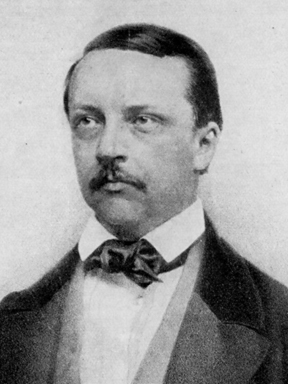 Soon, Hermann von Helmholtz was elected a professor of physics at the Medico-Surgical Academy, where he received his scientific education. Here, continuing his work on physiological acoustics and optics, he is more and more moving away from medicine, moving on to purely physical questions. He also received a request from William Thomson if he would like to take the chair of experimental physics in Cambridge, where the famous Maxwell and later the largest of modern physicists E. Rutherford were the first professor of physics.
Soon, Hermann von Helmholtz was elected a professor of physics at the Medico-Surgical Academy, where he received his scientific education. Here, continuing his work on physiological acoustics and optics, he is more and more moving away from medicine, moving on to purely physical questions. He also received a request from William Thomson if he would like to take the chair of experimental physics in Cambridge, where the famous Maxwell and later the largest of modern physicists E. Rutherford were the first professor of physics.
In 1873, another family tragedy struck him, his daughter Kat died. Helmholtz hard survived the loss of a loved one. But life goes on. October 15, 1877 Helmholtz is elected rector of the University of Berlin and at the same time publishes the work "On thinking and medicine", which is of the deepest interest until now.
In 1888, he was appointed president of the Physicotechnological State Institution; he combined this post with a professor of theoretical physics at the university until his death. Here he created works on physics, biophysics, physiology, and psychology. He developed a thermodynamic theory of chemical processes, introduced the concepts of free and bound energy. He laid the foundations of theories of the vortex motion of liquids and anomalous dispersion ...
Hermann Ludwig Ferdinand von Helmholtz died on September 8, 1894 at 1:00 11 am at the age of 72 at the age of 72 ... May the memory of blessed be of him!
Ivan Mikhailovich Sechenov studied with Helmholtz. How great was the impression made by the teacher on him can be judged by the following words:
- What can I say about this out of the ordinary person? Because of the insignificance of education I could not approach him, so I saw him, so to speak, only from afar, never remaining calm in his presence ... From his ... figures with pensive eyes blew in some sort of world, as if not from this world. Strange as it may seem, but I am telling the truth: he made an impression on me, similar to the one I was experiencing, looking for the first time at the Sistine Madonna in Dresden, all the more so that his eyes were really similar in expression to the eyes of this Madonna.
In Germany Hermann Ludwig Ferdinand von Helmholtz was considered a national treasure and were very unhappy with the description of one Englishman, which in appearance Helmholtz looked more like an Italian than a German.
HELMHOLTZ, HERMAN LUDWIG FERDINAND(Helmholtz, Hermann Ludwig Ferdinand von) (1821-1894), German physicist, mathematician, physiologist and psychologist. Born in Potsdam on August 31, 1821. In 1838 he graduated from high school. Despite his interest in physics, he could not go to university due to lack of funds. Having signed a commitment to serve for eight years as a military surgeon, he was admitted to the Military Medical Institute of Friedrich Wilhelm in Berlin. In 1842 he defended his thesis on physiology, in 1843-1848 he served as a military doctor in Potsdam. Here he became interested in physiology, which was taught by renowned physiologist I. Müller, became very close to the young researchers E. Dyuba-Raymond and E. Brücke, passionate about the idea of transforming physiology as a science by introducing methods of physics and chemistry.
In 1845 Helmholtz joined the Berlin Physical Society. From this time on, he began to travel regularly to Berlin, where he conducted experiments in the laboratory of the famous physicist G. Magnus. In 1845-1846 the main ideas of the scientist were formed, which served as the main part of his famous work. About saving power(Über die Erhaltubg der Kraft). July 23, 1847 Helmholtz made a report on this topic in the Physical Society. In it, he mathematically substantiated the law of conservation of forces (in modern scientific language, energy), showed its universality, introduced the concept of potential energy (in its terminology, tension), linked the law of conservation of energy with the impossibility of building a perpetual motion machine.
In 1848, Helmholtz was released from military service, and he holds the position of extraordinary professor of physiology and general pathology at the University of Königsberg. In 1855 he transferred to the University of Bonn, and in 1858 he became a professor of physiology in Heidelberg. All this time, continuing his studies in physiology. It measures the speed of propagation of nerve impulses, studies the process of muscle contraction. Helmholtz becomes the first person to see the retina of a living person’s eye; for this, he uses a special eye mirror, an ophthalmoscope, invented by him in 1850. His extensive studies on the physiology of vision (the theory of accommodation, color vision, etc.) were summarized in classical work Guide to physiological optics(Handbuch der physiologischen Optik, Bd. 1-3, 1856-1857). In 1856, Helmholtz’s acoustic work began with the study of combination tones. He built a model of the ear, which allowed to study the nature of the impact of sound waves on the organ of hearing, solved the so-called problem. organ tube, developed the theory of perception and making sounds. In addition, he conducts important studies of the vibration of strings and acoustic resonators (Helmholtz resonators), is engaged in the hydrodynamics of vortices, develops the principle of mechanical similarity, which allowed to explain a number of meteorological phenomena and the mechanism of formation of sea waves.
In 1870, Helmholtz was invited to Berlin, where the department headed by him and the laboratory became an informal center of physics in Germany. In 1888 he headed the Physicotechnical University, where both applied and fundamental research was conducted. Under the leadership of Helmholtz, the institute became a large scientific center, where young physicists from many countries, including from Russia, came to study.
In 1870-1880, Helmholtz was much concerned with the problems of electrodynamics, trying to find criteria for choosing in favor of one of the then existing electrodynamic theories. Under his influence, G. Hertz conducted research that led to the detection of electromagnetic waves. An important role in the development of electromagnetism was also played by Helmholtz’s own experiments, set by him as far back as 1869. Drawing attention to the oscillatory nature of the Leyden jar discharge, he showed that similar oscillations occur in an induction coil connected to a capacitor consisting of inductance and capacitance). In 1881, Helmholtz advanced the idea of the atomic nature of electricity, in 1882 he formulated the second law of thermodynamics in a form that allows it to be applied to chemical processes, and introduced the concepts of free and bound energy.
Helmholtz’s textbooks are widely known: Lectures on the electromagnetic theory of light(Vorlesungen über die elektromagnetische Theorie des Licht, 1897); Lectures on theoretical physics(Vorlesungen über theoretische Physik, Bd. 1-6, 1897-1907).
Helmholtz was a member of the Berlin, Prague, St. Petersburg Academy of Sciences and other scientific societies.
Literature Helmholtz G. Sound perception. St. Petersburg, 1875
Helmholtz G. About saving power. M. - L., 1934
Lebedinsky A.V., Frankfurt U.I., Frank A.M. Helmholtz. M., 1966
- In contact with 0
- Google+ 0
- OK 0
- Facebook 0

